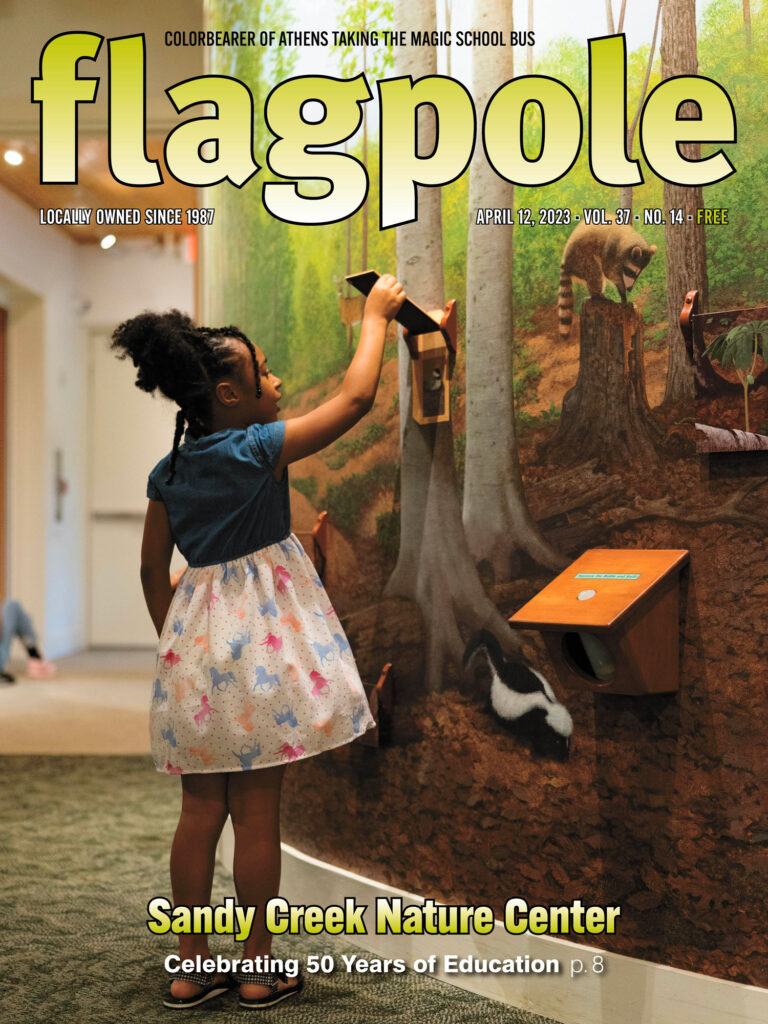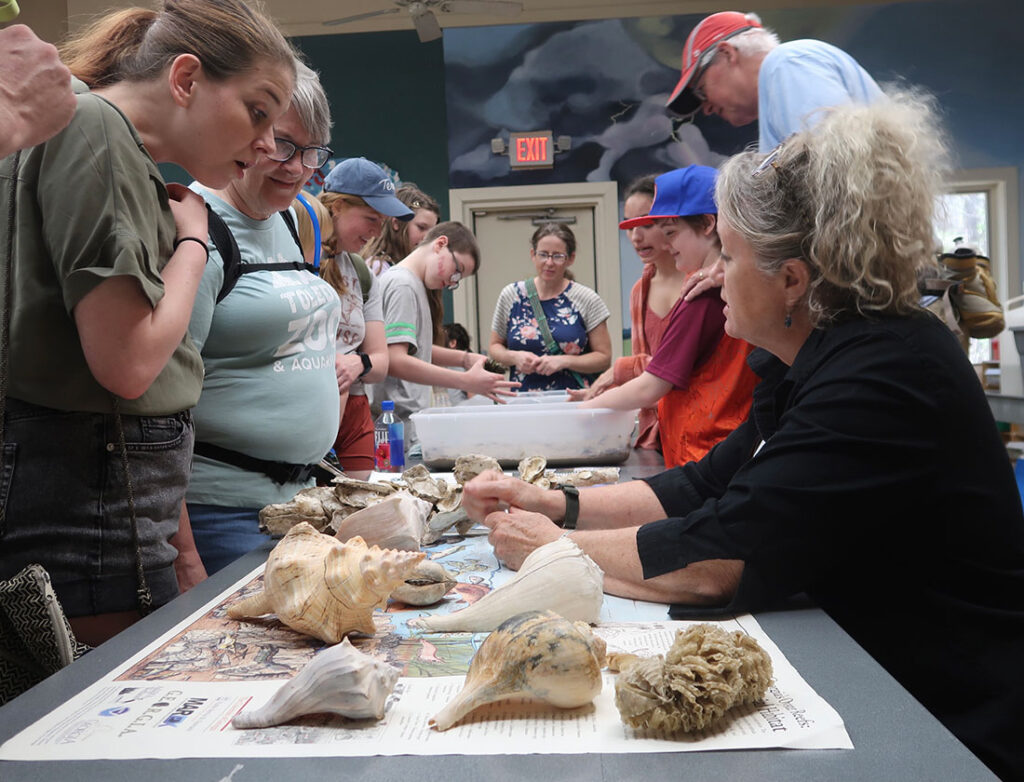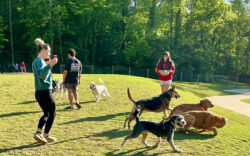For most people in Clarke County, Sandy Creek Nature Center is something that’s been there all their lives, a place to escape the noise and bustle of the city—one of the perks of living in Athens. But if not for a conversation between a University of Georgia graduate student and professor, the nature center (not to be confused with nearby Sandy Creek Park) might not exist at all.
Forestry graduate student Dan Hope went to Walt Cook, a professor in what is now the Warnell School of Forestry and Natural Resources, and said, “Why don’t we start a nature center?” recalled Cook recently.
Cook, 91, didn’t know then exactly what a nature center was, he admits. But intrigued, he went with Hope—who was also director of the City of Athens’ parks department—to meet a man named John Ripley Forbes, who was spreading the gospel of environmental education in those days right after the first Earth Day, as people were beginning to grasp the harms our chemical-laced modern lives were inflicting on nature., and on ourselves.
Forbes, credited now with starting hundreds of nature and science centers across the country, said he’d loan them $3,000 in seed money to purchase land for the center if they’d put together a serious group of people to plan and raise money. They did, and by 1973, they’d found nine other people to round out an 11-member board for the new nonprofit. They got to work raising funds, first to buy a 110-acre tract around the confluence of Sandy Creek and the North Oconee River. After additions, its area now is 225 acres.
“It was important to preserve the land itself, but also to teach people why we wanted to preserve it and why it was important,” said Suzanne Lindsay, one of the three surviving early nature center board members, with Hope and Cook.
They convinced the city and county governments, separate then, to chip in to buy the land, and matched that money with a grant from a program then-Gov. Jimmy Carter had launched to preserve important natural areas.
Part of the land, a dead-end on a portion of an old road to Commerce, had become a dumping ground, recalled Lindsay. Volunteers hauled out “load upon load of trash and abandoned materials, hoping their trucks would not bog down,” Lindsay wrote in a 40-year history of Sandy Creek Nature Center.
“The reason I wanted a nature center was to educate kids and the general public, especially the teachers,” said Cook, who’s had a hand in well over 100 nature trails around the state—designing, consulting, sometimes actually building and maintaining them.
At that time, UGA’s College of Education did not have a course that allowed future teachers “to go out on the ground,” Cook said. The teachers coming out of the college knew nothing about the environment, and if the teachers didn’t know, they couldn’t teach their students. “I wanted to fill that gap,” he said.

Now, the Sandy Creek Nature Center is one of Athens’ top visitor destinations with more than 60,000 visits a year, according to Randy Smith, facilities supervisor of the nature center, which is observing its 50th anniversary this year.
The nature center opened to the public in 1977, and in its early years was operated by the nonprofit corporation. But in 1981, the board turned it over to the Clarke County government to operate, nine years before voters approved consolidating the Athens and Clarke County governments. Now the nature center is a part of the Athens-Clarke County Leisure Services Department.
Some of the people on that nature center board went on to become founders of the Oconee River Land Trust, which has now protected more than 43,000 acres of land from development across the state, and to oversee the early stages of the growing greenway system along some of Athens’ river corridors.
When Clarke County took over operating the nature center, the role of the nonprofit’s board became more of an advisory and fundraising relationship, said Sandy Creek Nature Center Inc. President Emily Carr. Over the years, the foundation has raised more than $2 million for the nature center, not counting volunteer hours, including recently a playscape downslope from the nature center’s interpretive center and its classrooms and exhibits.
Fifty years on, people of all ages come to walk its trails, and tens of thousands of Clarke County children come each year to learn about nature hands-on and close-up. Under an agreement with the Clarke County School District, by sixth grade every Clarke County public school student will have made four annual trips to the nature center for classes, which always include an outdoor component. Hundreds more youngsters come to the center’s summer camps, and all through the year the center and its programs also draw in local private school and homeschooled children.

It also stages special events, like the annual Snake Day coming up May 13, which usually draws hundreds to the 225-acre nature center off Commerce Road, about a mile north of downtown. “We really operate at capacity a lot of the time,” Smith said.
“It has become much more than anyone could envision 50 years ago,” Lindsay said.
It’s a place of survival for salamanders, beavers, birds, turtles and other wildlife, but it’s also a place where children can learn not to be afraid of the woods, as many children are. “We give them a chance to go into the woods and feel safe, and see it as an interesting place,” said Carr, a former Clarke County teacher who brought classes to the nature center.
“If a child is taught early, you’ve got a pretty good chance it will carry on into adult life,” Lindsay said.
Something more intangible may be even more important than the education the nature center’s small staff provides, with the help of hundreds of volunteers: Carr has seen youngsters come to feel a kind of ownership. “You could just see a feeling of, ‘It belongs to me,’” Carr said. “It gives people a sense of where we live.”
Humanity hasn’t come close to solving its environmental problems in the half-century since Sandy Creek was founded, which makes the nature center even more important today, Hope believes.
“If we don’t keep educating young people, we’re really going to be in trouble, and that’s what Sandy Creek does,” Hope said. “You can only hope those little ones grow up to be wiser than we have been.”

Like what you just read? Support Flagpole by making a donation today. Every dollar you give helps fund our ongoing mission to provide Athens with quality, independent journalism.










